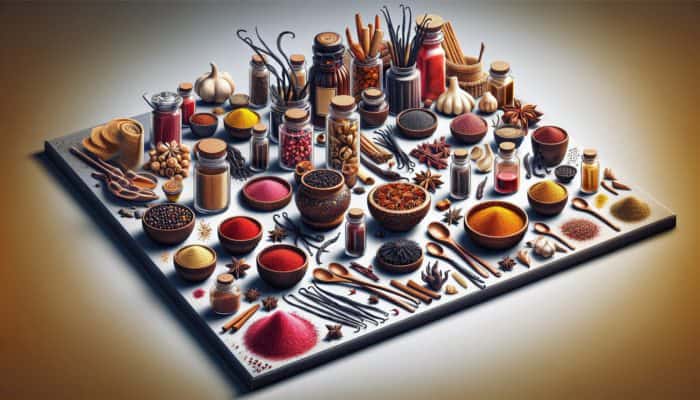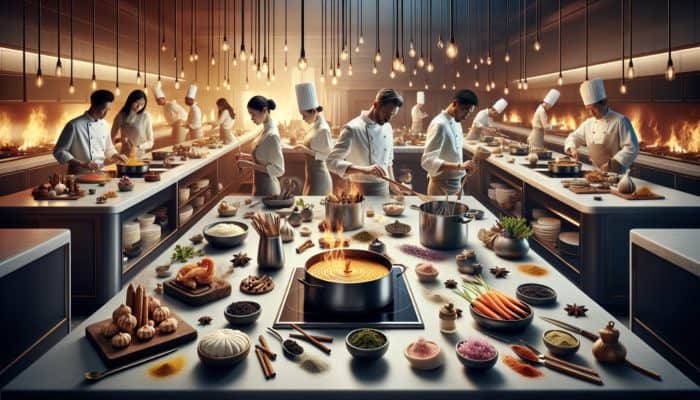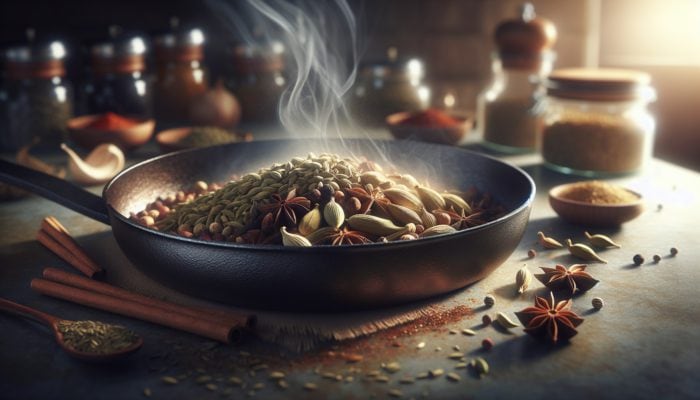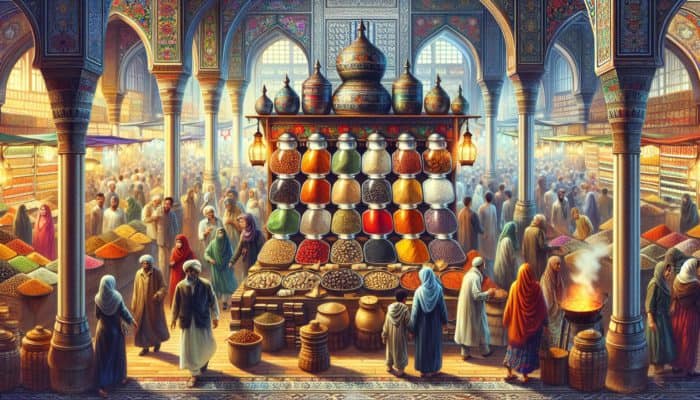Discover the World of Rare Spices
What Exactly Are Rare Spices?

How to Cook With Rare Spices Like Saffron: Rare spices are distinctive culinary treasures that are not typically featured in everyday cooking, often due to their unique flavours and high market prices. These exceptional spices bring a unique character to dishes, elevating them from the mundane to the extraordinary. Some prime examples of rare spices include Saffron, vanilla beans, black garlic, cardamom pods, sumac, and grains of paradise. Their scarcity, combined with their remarkable ability to transform even the simplest recipes into gourmet experiences, sets them apart in the culinary world.
The allure of rare spices is not only about their taste but also their rich cultural significance. Many of these spices have fascinating histories tied to specific regions, enhancing their value not just in flavour but also in storytelling. By integrating rare spices into your cooking, you not only enrich your dishes but also forge a connection with diverse culinary traditions from around the world.
Where Can You Source Quality Rare Spices?
Locating rare spices can be challenging, yet numerous options are available for the discerning cook. Specialty stores, gourmet food shops, and online platforms have increasingly made these elusive ingredients accessible. When sourcing rare spices, prioritising freshness and authenticity is essential to achieve the best culinary results. Here are some effective tips for sourcing these spices:
- Explore local farmers' markets or specialty food stores for the freshest supplies available.
- Investigate online retailers that specialise in rare spices to guarantee authenticity.
- Join culinary communities or forums for recommendations on trusted sources.
- Check for certifications or customer reviews when purchasing spices online.
- Consider buying in bulk to save costs on frequently used spices.
For those seeking the most vivid flavours and aromas, reaching out to producers or wholesalers can also unveil high-quality options. Cultivating relationships with suppliers can lead to exclusive finds and insights into their origins, thereby enhancing your culinary journey.
How to Store Rare Spices for Maximum Longevity
Proper storage is paramount to preserving the potency and flavour of rare spices. Exposure to air, light, and moisture can diminish the quality of these items over time, making it crucial to store them properly. Here are some effective methods for maintaining the longevity of your rare spices:
- Utilise airtight containers to limit exposure to air and moisture.
- Store spices in a cool, dark location away from direct sunlight.
- Label containers with purchase dates to easily track freshness.
- Avoid placing spices near heat sources, such as stoves and ovens.
- Refrain from storing spices in transparent glass containers that allow light to penetrate.
By adhering to these storage techniques, you can significantly extend the shelf life of your rare spices, ensuring they retain their full flavour potential when required. With proper care, these exquisite spices will enhance your culinary repertoire for years to come.
Innovative Culinary Uses for Rare Spices

Rare spices can serve as the secret ingredient that elevates an ordinary dish into an extraordinary culinary creation. They are often featured in gourmet cooking, traditional recipes, and experimental cuisine. The culinary possibilities are vast, ranging from intricate desserts to savoury mains. Some example dishes that incorporate rare spices include:
- Risotto infused with saffron for a luxurious touch.
- Cardamom-spiced carrot cake to elevate dessert experiences.
- Grilled meats marinated with sumac for a tangy kick.
- Vanilla bean crème brûlée, showcasing the spice's depth.
- Black garlic pasta offers a sweet and umami-rich experience in every bite.
These examples illustrate how rare spices can add unique flavours and elevate dishes to a new level. Incorporating them not only enhances taste but also introduces diners to new sensory experiences, transforming every meal into a culinary adventure.
Insights from Experts on Cooking with Rare Spices like Saffron
How Can You Maximise the Flavour of Saffron?
To fully maximise the flavour of saffron, it is essential to understand its unique properties. This spice is renowned for its subtle yet complex taste, which can easily be overshadowed if not used correctly. The key is to use saffron sparingly and to allow it to steep in warm liquid before adding it to your dishes. This process helps unlock its full flavour and colour potential.
For instance, in traditional dishes such as paella or risotto, incorporating saffron into warm broth allows the spice to release its vibrant hue and delicate aroma throughout the dish. Similarly, when preparing a simple broth, adding saffron threads to simmering water allows for the infusion of its rich flavours into the base. This technique can be adapted to various cuisines, from Moroccan tagines to Italian sauces, showcasing saffron's versatility in elevating dishes.
What Techniques Enhance the Aroma of Rare Spices?

Enhancing the aroma of rare spices is an essential technique that can significantly elevate your culinary creations. Aroma plays a crucial role in cooking, as it engages the senses and enhances overall enjoyment. One proven method to unlock the full potential of spices is through toasting them before use. This technique releases essential oils and intensifies their fragrance.
To toast spices, follow these actionable steps:
1. Heat a dry skillet over medium heat.
2. Add the whole spices (such as cardamom pods or cumin seeds) in a single layer.
3. Stir continuously for a few minutes until they become fragrant and slightly darker in colour.
4. Allow them to cool before grinding, as this preserves their flavour.
This method is particularly effective for spices like bay leaves or fenugreek, adding depth to your dishes. Experimenting with toasting can reveal new dimensions in familiar recipes, making each meal a chance to discover something extraordinary.
How to Pair Rare Spices with Other Ingredients for Optimal Flavour
Pairing rare spices with other ingredients can create harmonious flavours that elevate your dishes to gourmet levels. Understanding the characteristics of each spice and its compatibility with various ingredients can lead to delightful culinary experiences. For example, saffron pairs beautifully with seafood, offering a delicate contrast to the ocean's brininess, while cardamom complements sweet ingredients like chocolate or fruit.
When experimenting with pairings, consider the following combinations:
- Saffron with seafood and citrus for a Mediterranean flair.
- Vanilla with fruits and cream to enhance dessert richness.
- Black garlic paired with roasted vegetables adds a sweet and umami-rich flavour.
- Sumac with grilled meats for a tangy finish.
By taking the time to experiment with different combinations, you will discover unique pairings that resonate with your palate, leading to flavour profiles that surprise and delight.
How Do Rare Spices Affect Health?
What Are the Health Benefits of Saffron?
Saffron is not only a culinary gem but also a spice with numerous health benefits. Studies have linked saffron to mood enhancement, making it a valuable addition to a balanced diet. Its rich antioxidant properties contribute to overall well-being and have been linked to various health benefits. Some key health benefits of saffron include:
- Improved mood and reduced symptoms of depression.
- Enhanced cognitive function and memory.
- Antioxidant properties that combat oxidative stress.
- Potential benefits for menstrual health and relief.
Incorporating saffron into your meals can be a delicious way to promote health while enjoying its unique flavours. It serves as a reminder that rare spices can offer both culinary and medicinal benefits, thereby enhancing the overall dining experience.
Can Rare Spices Improve Digestive Health?
Certain rare spices have been recognised for their ability to aid digestion, making them valuable additions to your culinary repertoire. Spices such as ginger and fennel are known to stimulate digestive enzymes, helping the body break down food more efficiently. They can also soothe digestive discomfort and reduce inflammation in the gut.
For instance, incorporating ginger into a stir-fry can not only enhance flavour but also promote digestive health. Similarly, fennel seeds can be brewed into a tea after meals to aid digestion. Other spices, such as turmeric, can also play a role in reducing gut inflammation, making them essential for those seeking to maintain gastrointestinal health.
Are There Any Potential Side Effects of Rare Spices?
While rare spices offer numerous health benefits, it is essential to use them in moderation, as excessive consumption can lead to adverse effects. For instance, saffron, though safe in culinary amounts, can cause side effects such as nausea or dizziness when consumed in large quantities. Other rare spices, like nutmeg, can be harmful in excess, causing hallucinogenic effects.
To ensure a safe culinary experience, it is crucial to be aware of the recommended usage levels for each spice and to consult with a healthcare professional if you have any concerns. By enjoying rare spices in moderation, you can savour their unique flavours while minimising any potential risks.
Essential Cooking Techniques for Rare Spices
How to Infuse Rare Spices into Dishes Effectively
Infusing rare spices into dishes can significantly enhance their flavour profiles. This technique enables the spices to blend seamlessly with other ingredients, resulting in a cohesive and aromatic dish. Infusion can be achieved through steeping or simmering, depending on the dish.
To infuse spices effectively, start by selecting the appropriate method based on your recipe. For example, when making a broth, add whole spices such as bay leaves or cloves directly to the simmering liquid. Allow them to steep for a designated time, then remove them before serving. For cream-based sauces, consider heating the cream with spices like saffron or cardamom and letting it steep for a few minutes before straining it into the sauce. This approach ensures the spices impart their flavours without leaving behind any gritty remnants.
Using this infusion method not only enhances the taste but also creates an aromatic layer to your dishes, generating a sensory experience that engages both taste and smell.
What Are the Best Methods for Grinding Rare Spices?
Grinding rare spices just before use is a practice that can significantly preserve their flavour and aroma. Maintaining the integrity of these spices is essential for achieving the full culinary impact. Two effective methods for grinding spices include using a mortar and pestle or a spice grinder.
When using a mortar and pestle, the process allows for better control over the coarseness of the grind, which can be adjusted based on your recipe requirements. Place the spices into the mortar and use the pestle to crush and grind them until you achieve the desired consistency. Conversely, a spice grinder offers efficiency and uniformity, making it ideal for larger quantities.
Regardless of the method chosen, freshly ground spices will always offer a more potent flavour and aroma compared to pre-ground options, enhancing your dishes with their vibrant characteristics.
How to Use Rare Spices in Marinades and Rubs
Rare spices can add remarkable depth and complexity to marinades and rubs, making them essential components in flavourful dishes. When creating a marinade, consider how the unique qualities of rare spices can enhance the overall taste of meats, vegetables, or tofu.
For example, saffron can be steeped in olive oil or yogurt to create a luxurious marinade for chicken or lamb. Mix saffron threads with warm liquid, allow them to infuse, and then combine with spices like cumin, garlic, and lemon juice. This combination not only enhances the protein but also introduces a vibrant colour and aroma.
Similarly, creating a spice rub using a blend of rare spices, such as smoked paprika, sumac, and black garlic, can elevate the flavour of roasted vegetables or grilled meats. The combination of these spices will not only enhance the flavour but also provide a beautiful appearance, making every dish a feast for the eyes as well as the palate.
Research-Backed Benefits of Cooking with Rare Spices like Saffron
How Does Saffron Influence Culinary Creativity?
Saffron's unique flavour profile and striking colour can inspire chefs to push the boundaries of their creativity in the kitchen. Its versatility allows for experimentation in both sweet and savoury recipes, which can lead to innovative dishes that captivate diners. The complexity of saffron encourages chefs to think beyond traditional pairings, sparking a culinary dialogue that results in exciting new flavours.
For instance, saffron can be used in unconventional desserts, such as saffron-infused panna cotta or spiced custards, providing a rich and luxurious finish. In savoury applications, it can enhance a variety of dishes, from risottos to soups, encouraging chefs to explore its potential in unexpected contexts. By incorporating saffron, culinary professionals can create visually stunning plates that evoke intrigue and surprise.
This creative potential not only enriches individual dishes but also contributes to the broader culinary landscape, inspiring chefs worldwide to explore the possibilities of rare spices.
What Studies Show About the Use of Rare Spices in Cooking?
Research has demonstrated that rare spices can enhance the nutritional value and flavour of dishes, making them invaluable additions to both traditional and modern cuisines. Studies highlight the role of spices in promoting health and well-being, showcasing their potential as natural flavour enhancers that reduce the need for salt and sugar.
For instance, studies have shown that spices like turmeric and ginger not only add depth and flavour to dishes but also provide anti-inflammatory benefits. Additionally, the incorporation of spices such as saffron and cardamom has been linked to improved digestion and metabolic health. These studies underscore the importance of incorporating rare spices into culinary practices, highlighting their ability to enhance both taste and nutritional profiles.
By understanding the research surrounding rare spices, home cooks and professional chefs can make informed decisions about their culinary practices, ultimately leading to healthier and more flavourful meals.
Can Rare Spices Elevate the Dining Experience?
Rare spices have the power to transform a meal into a memorable dining experience by engaging multiple senses. Their unique flavours and aromas create a sensory journey for diners, enhancing not only the taste but also the overall atmosphere of the meal. The thoughtful use of rare spices can turn ordinary dishes into extraordinary ones, making dining feel special.
For instance, using saffron in a risotto not only elevates the dish visually with its vibrant hue but also adds a layer of complexity that can transport diners to distant lands. Similarly, employing spices like smoked paprika or cardamom can evoke nostalgia, making the dining experience more personal and evocative. To elevate your dining experience, consider these actionable steps:
- Incorporate rare spices into signature dishes to create a unique identity.
- Pair flavours thoughtfully to create a balanced menu.
- Utilise spices to enhance seasonality and local ingredients.
- Encourage diners' engagement by sharing stories about the spices used in the dishes. In the dishes
By embracing the potential of rare spices, chefs can create a dining experience that not only satisfies hunger but also leaves a lasting impression on guests.
How Can Saffron Improve Health Outcomes?
Saffron has been associated with various health benefits, making it a valuable addition to both culinary and wellness applications. Research has shown that saffron may have a positive impact on mood, cognitive function, and even reproductive health. Its antioxidant properties play a crucial role in combating oxidative stress, which can lead to the development of chronic diseases.
Incorporating saffron into your cooking can not only enhance flavour but also contribute to a healthier lifestyle. For example, adding saffron to soups, stews, or rice dishes can provide a nourishing boost, in addition to its culinary benefits. Chefs and home cooks alike are increasingly seeking ways to utilise saffron not only for its taste but also for its potential health outcomes, making it a sought-after ingredient in modern cuisine.
What Are the Economic Benefits of Using Rare Spices?
Incorporating rare spices like saffron into menus can offer significant economic benefits for chefs and restaurants. The unique flavours and visual appeal of rare spices justify higher menu prices, leading to increased profit margins. By utilising these spices creatively, chefs can attract discerning diners who seek out distinctive culinary experiences.
Additionally, rare spices can elevate a restaurant's brand, positioning it as a destination for gourmet dining. As diners become more adventurous and curious about flavour, restaurants that embrace rare spices can differentiate themselves in a competitive marketplace. This not only enhances customer satisfaction but also fosters loyalty, encouraging repeat business.
Through strategic pricing and effective marketing of rare spices, chefs can unlock new profit streams while simultaneously contributing to the richness and diversity of the culinary landscape.
How Can You Seamlessly Incorporate Rare Spices into Daily Cooking?
What Are Simple Ways to Use Saffron in Everyday Meals?
Incorporating saffron into everyday meals doesn't have to be reserved for special occasions. This versatile spice can easily enhance the flavour of common dishes, turning them into culinary delights. One simple way to use saffron is to add it to rice dishes, where its vibrant colour and unique flavour can shine.
For example, a basic saffron-infused risotto can be made by adding a pinch of saffron threads to the broth while cooking your rice, allowing the flavours to meld beautifully. Saffron can also be added to soups, curries, or even scrambled eggs to create a luxurious touch without requiring elaborate preparation. These straightforward applications demonstrate that saffron can be an everyday ingredient, making meals feel special without excessive effort.
By adopting these simple recipes, home cooks can enjoy the rich flavours of saffron regularly, enhancing their culinary routine.
How to Add Rare Spices to Breakfast Dishes
Breakfast is an excellent opportunity to incorporate rare spices into your meals, adding unique flavours that can invigorate your morning routine. Consider experimenting with spices like cardamom or cinnamon in your oatmeal or smoothie bowls to create a warm and comforting start to the day. Cardamom, with its aromatic qualities, pairs exceptionally well with fruits and dairy, elevating standard breakfast items to new heights.
For instance, a spiced oatmeal can be made by adding ground cardamom and a touch of saffron to your usual oats, creating a fragrant dish that's both nourishing and satisfying. Additionally, using rare spices in scrambled eggs or frittatas can add depth to your morning protein.
By embracing these flavourful combinations, breakfast can become not just a meal but an indulgent experience that fuels your day ahead.
Using Rare Spices in Desserts and Sweets
Rare spices can lend an exotic twist to desserts, transforming simple sweets into extraordinary culinary creations. Incorporating spices like saffron or vanilla into cakes, cookies, and ice creams opens up a world of flavour possibilities that delight the palate.
For example, a saffron-infused panna cotta can provide a luxurious finish to a dinner party, while cardamom can add a unique flavour to a batch of chocolate chip cookies. Consider using vanilla beans in custards or ice creams for a rich, aromatic experience.
These applications showcase the versatility of rare spices in desserts, proving that they can elevate sweets to new heights. By experimenting with these flavour combinations, you can create dessert experiences that not only satisfy but also surprise and delight your guests.
Effective Strategies for Cooking with Rare Spices like Saffron
How Can You Ensure the Quality of Rare Spices?
Ensuring the quality of rare spices is essential for achieving the best flavours and culinary results. When sourcing spices like saffron, look for reputable suppliers with a track record of quality. Checking for freshness and authenticity is crucial, as inferior products can lead to disappointing culinary experiences.
To guarantee quality, consider the following strategies:
- Research suppliers and read customer reviews before making a purchase.
- Look for spices with clear labelling and origin information.
- Purchase from specialty stores that focus on gourmet products.
- Ask about the spice's harvest date or batch number for greater transparency.
By prioritising quality sourcing, you can enhance your culinary creations and ensure that the flavours of rare spices shine in your dishes.
What Are the Best Practices for Cooking with Rare Spices?
Cooking with rare spices requires attention to detail and an understanding of their unique characteristics. Using them sparingly and at the right time is critical to maximising their impact. One of the best practices is to consider the cooking method when incorporating spices. For example, adding delicate spices like saffron towards the end of cooking helps retain their flavour and aroma.
Another best practice is to combine spices thoughtfully, ensuring that their flavours complement rather than overpower each other. Experimenting with different quantities can help you find the perfect balance in your dishes. Additionally, toasting spices before use enhances their flavour, unlocking their full potential.
By adopting these best practices, you can create dishes that highlight the beauty and complexity of rare spices, ensuring your cooking is both flavourful and memorable.
How to Balance Flavours with Rare Spices
Balancing the flavours of rare spices with other ingredients is key to creating harmonious dishes. Each spice has its unique characteristics, and understanding how to pair them effectively can lead to delightful culinary experiences. When experimenting with rare spices, start with small amounts to avoid overpowering the dish.
For example, saffron's delicate flavour can be balanced with creamy ingredients, while spices like cardamom may work well with sweet components. It’s also valuable to consider the texture of spices and how they interact with other ingredients in your dish.
Through careful experimentation and observation, you can discover the specific ratios and pairings that best suit your palate, leading to exceptional culinary creations that showcase the beauty of rare spices.
Where to Source Rare Spices Like Saffron?
Finding reliable sources for rare spices is crucial for both home cooks and professional chefs. Local and international suppliers can offer high-quality saffron and other spices, making it essential to explore both options. Ethically sourcing spices is also important to ensure sustainability and quality.
To source rare spices like saffron effectively, consider these options:
- Local farmers' markets for fresh and seasonal finds.
- Online specialty retailers are known for gourmet products.
- Ethical or organic suppliers that ensure sustainability.
- Wholesalers who have established relationships with farmers for authenticity.
By utilising a combination of these sources, you can ensure that your kitchen is stocked with the finest rare spices, enhancing your culinary creations while supporting sustainable practices.
How to Store Rare Spices to Maintain Their Potency?
Proper storage is vital to preserving the potency of rare spices, ensuring they remain vibrant and flavourful over time. The ideal storage conditions involve keeping spices in airtight containers, away from light and heat.
Consider these tips for maintaining the freshness of your spices:
- Use glass or opaque containers to prevent light exposure.
- Store spices in a cool, dark place, like a pantry or cupboard.
- Label containers with purchase dates for easy tracking of freshness.
- Keep spices sealed tightly to avoid air exposure.
By adhering to these storage practices, you can extend the shelf life of rare spices, ensuring they deliver their full potential whenever you need them. Investing in proper storage techniques pays dividends in flavour and culinary satisfaction.
Frequently Asked Questions About Rare Spices
What exactly is saffron, and why is it considered a rare spice?
Saffron is a spice derived from the flower of Crocus sativus, commonly known as the saffron crocus. It is considered rare due to the labour-intensive harvesting process, requiring thousands of flowers to produce just a small amount of saffron.
How long does saffron last when stored properly?
When stored in an airtight container, away from light and heat, saffron can last for up to four years, maintaining its potency and flavour.
Can rare spices be used in everyday cooking?
Absolutely! Rare spices can enhance everyday meals and make them extraordinary. Simple applications in rice dishes, soups, or marinades allow for frequent use without excessive expense.
Are there any health risks associated with consuming saffron?
While saffron is safe in culinary amounts, excessive consumption can lead to side effects such as nausea or dizziness. Moderation is key for a safe culinary experience.
What are some common dishes that benefit from saffron?
Saffron is commonly used in dishes such as paella, risotto, bouillabaisse, and various desserts. Its unique flavour and vibrant colour significantly enhance these recipes.
How do I know if saffron is authentic?
Authentic saffron has a deep, rich red hue and a distinct, aromatic scent. Look for reputable suppliers and check for certifications to ensure authenticity.
What spices pair well with saffron?
Saffron pairs well with ingredients like seafood, chicken, citrus, and creamy sauces. Other complementary spices include cardamom and cumin, which enhance its unique flavour.
Can I grow my own saffron at home?
Yes, saffron can be grown at home, but it requires specific conditions. It thrives in well-drained soil and needs a warm climate with plenty of sunlight to flourish.
What is the best way to infuse saffron's flavour?
To infuse the flavour of saffron, steep the threads in warm liquid (such as broth or water) for about 10-15 minutes before adding them to your dish, allowing its rich colour and flavour to meld beautifully.
How can I incorporate rare spices into my diet?
Start by adding small amounts of rare spices to your favourite recipes, whether in marinades, desserts, or breakfast dishes. Gradual experimentation helps you discover new flavours and expand your culinary horizons.



Your exploration of rare spices sheds light on their profound impact not only on flavor but also on cultural heritage. I’ve always been fascinated by how spices like saffron possess such an intricate history rooted in ancient trade routes and culinary traditions. For instance, saffron, often referred to as “red gold,” has been valued in Persian culture for centuries, not just for its distinct flavor, but also for its vibrant color and medicinal properties.
This exploration of rare spices truly resonates with anyone who has delved into the culinary arts or who simply appreciates the profound impact that these ingredients can have on a dish. The notion of rarity in spices is fascinating not only for their flavors but also for the stories they carry—from the arduous labor involved in harvesting saffron to the deep cultural significance of the spices in local cuisines around the world.
You’ve hit the nail on the head with your thoughts on rare spices and their backstories. It’s almost like each spice has its own biography—complete with plot twists, unsung heroes, and maybe even a dash of drama. Take saffron, for instance; it’s not just a pretty face in the spice world. The fact that it’s harvested by hand, laboriously plucking the delicate stigmas of the crocus, feels like something straight out of an Indiana Jones movie. You can almost imagine the farmers, treasure maps in hand, chasing after the elusive strands, trying to extract something so precious that it costs more by weight than gold.
You’ve captured the essence of spices perfectly. They really do have these fascinating backstories that often get overlooked amidst the grind of everyday cooking. Saffron, in particular, is a great example—not just because of its intricate harvesting process but also how it connects to cultural practices across centuries. I read somewhere that it’s been used not just in cuisine but also in traditional medicine in various cultures. It’s interesting to think about how a single spice can carry so much history and depth.
You know, crafting a multi-course tasting menu is like curating a culinary adventure, where each dish tells its own story—much like those rare spices, each adding depth and character to the overall experience.
‘How to Create a Multi-Course Tasting Menu: A Universal Guide’
https://cookinggods.com/how-to-create-a-multi-course-tasting-menu-a-universal-guide/.